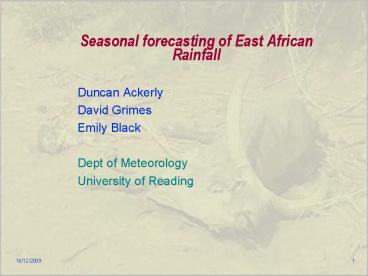Seasonal forecasting of East African Rainfall - PowerPoint PPT Presentation
1 / 16
Title:
Seasonal forecasting of East African Rainfall
Description:
Cumulative decile forecast results. 11/28/09. 14. Forecast Success by Quintile. 1=very low 4 = high ... in forecasting rainfall anomalies to within two deciles ... – PowerPoint PPT presentation
Number of Views:105
Avg rating:3.0/5.0
Title: Seasonal forecasting of East African Rainfall
1
Seasonal forecasting of East African Rainfall
- Duncan Ackerly
- David Grimes
- Emily Black
- Dept of Meteorology
- University of Reading
2
Overview of Talk
- Background
- Need for seasonal forecasts
- East African rainfall
- Methodology
- local forecast
- statistical regression model based on SSTs
- Results
- assessment of skill
- comparison with persistence, climatology and
random forecast
3
Background
- The majority of people in East Africa rely on
subsistence agriculture - Agriculture is rainfall limited
- Accurate seasonal forecast would allow
- better economic planning
- earlier identification of food shortage
4
Case study
- Use March April May (MAM) rainfall in Kenya as
case study
5
Approaches to seasonal forecasting
- Two approaches to seasonal forecast
- NWP model
- use numerical weather model run out to time scale
of months - statistical
- look for statistical relationship between
rainfall and likely predictors
6
This project
- Statistical model
- Monthly mean Sea Surface Temperature (SST) with
lead time of 1 or more months as predictor
variables - rainfall anomaly within local zones as target
variable
7
Methodology
- Divide Kenya into zones based on spatial
correlation of MAM rainfall. - For each zone
- identify SST regions in preceding months which
best correlate with MAM rainfall anomaly - Perform regression to establish relationship
between SSTs and rainfall anomaly - Use cross validation to test robustness of method
8
Raingauge data
- 53 gauges from 1993 to 2001 used to establish
zones - 27 gauges from 1949 to 1985 used to calibrate and
validate regression model for each zone
9
Rainfall zones
- Rainfall zones were defined as areas delineating
clusters of highly correlated MAM gauge totals
2
4
2
4
5
6
1
6
1
3
3
5
10
SST teleconnections
- Correlation between mean MAM for Zone 1 and SST
using NCEP reanalysis data
11
SST teleconnections
2
5
4
6
1
3
12
Cross validation time series comparison
13
Cumulative decile forecast results
14
Forecast Success by Quintile
- 1very low 4 high
- 2 low 5 very high
- 3 average
15
Conclusions
- A local seasonal rainfall forecast model based on
correlation with SSTs with a lead time between 1
and 3 months has been developed - The model has been tested using MAM rainfall data
from Kenya - Zones closest to the coast show highest lagged
correlations with Indian Ocean SSTs. - Inland zones show highest lagged correlation with
areas in the Atlantic and Pacific - For 4 out of 6 zones there is significant skill
in forecasting rainfall anomalies to within two
deciles
16
Intra-zonal correlation matrix































